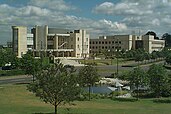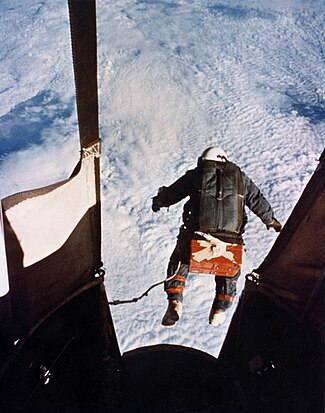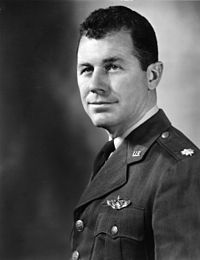Portal:Aviation
| Main page | Categories & Main topics |
|
Tasks and Projects |
The Aviation Portal

Aviation includes the activities surrounding mechanical flight and the aircraft industry. Aircraft includes fixed-wing and rotary-wing types, morphable wings, wing-less lifting bodies, as well as lighter-than-air craft such as hot air balloons and airships.
Aviation began in the 18th century with the development of the hot air balloon, an apparatus capable of atmospheric displacement through buoyancy. Some of the most significant advancements in aviation technology came with the controlled gliding flying of Otto Lilienthal in 1896; then a large step in significance came with the construction of the first powered airplane by the Wright brothers in the early 1900s. Since that time, aviation has been technologically revolutionized by the introduction of the jet which permitted a major form of transport throughout the world. (Full article...)
Selected article
Selected image
Did you know
...that four planes were simultaneously hijacked in the 1970 Dawson's Field hijackings?

...that François Denhaut built the world's first flying boat, or seaplane with a hull?
General images -
In the news
- May 29: Austrian Airlines cancels Moscow-bound flight after Russia refuses a reroute outside Belarusian airspace
- August 8: Passenger flight crashes upon landing at Calicut airport in India
- June 4: Power firm helicopter strikes cables, crashes near Fairfield, California
- January 29: Former basketball player Kobe Bryant dies in helicopter crash, aged 41
- January 13: Iran admits downing Ukrainian jet, cites 'human error'
- January 10: Fire erupts in parking structure at Sola Airport, Norway
- October 27: US announces restrictions on flying to Cuba
- October 3: World War II era plane crashes in Connecticut, US, killing at least seven
- September 10: Nevada prop plane crash near Las Vegas leaves two dead, three injured
- August 6: French inventor Franky Zapata successfully crosses English Channel on jet-powered hoverboard
Related portals
Associated Wikimedia
The following Wikimedia Foundation sister projects provide more on this subject:
-
Commons
Free media repository -
Wikibooks
Free textbooks and manuals -
Wikidata
Free knowledge base -
Wikinews
Free-content news -
Wikiquote
Collection of quotations -
Wikisource
Free-content library -
Wikiversity
Free learning tools -
Wikivoyage
Free travel guide -
Wiktionary
Dictionary and thesaurus
Selected biography
His career began in World War II as a private in the U.S. Army Air Forces. After serving as an aircraft mechanic, in September 1942 he entered enlisted pilot training and upon graduation was promoted to the rank of Flight Officer (WW 2 U.S. Army Air Forces rank equivalent to Warrant Officer) and became a P-51 Mustang fighter pilot. After the war he became a test pilot of many kinds of aircraft and rocket planes. Yeager was the first man to break the sound barrier on October 14, 1947, flying the experimental Bell X-1 at Mach 1 at an altitude of 45,000 ft (13,700 m). Although Scott Crossfield was the first man to fly faster than Mach 2 in 1953, Yeager shortly thereafter exceeded Mach 2.4.[1] He later commanded fighter squadrons and wings in Germany and in Southeast Asia during the Vietnam War, and in recognition of the outstanding performance ratings of those units he then was promoted to Brigadier-General. Yeager's flying career spans more than sixty years and has taken him to every corner of the globe, even into the Soviet Union during the height of the Cold War.
Selected Aircraft

The Airbus A340 is a long-range four-engined widebody commercial passenger airplane manufactured by Airbus. The latest variants (-600 & A340E) competed with Boeing's 777 series of aircraft on long-haul and ultra long-haul routes, but it has since been succeeded by the Airbus A350.
The A340-600 flies 380 passengers in a three-class cabin layout (419 in 2 class) over 7,500 nautical miles (13,900 km). It provides similar passenger capacity to a 747 but with twice the cargo volume, and at lower trip and seat costs.
The A340-600 is more than 10 m longer than a basic -300, making it the second longest airliner in the world, more than four meters longer than a Boeing 747-400.
- Span: 63.45 m (208 ft 2 in)
- Length: 75.30 m n(246 ft 11 in)
- Height: 17.30 m (56 ft 9 in)
- Engines: four 56,000 lbf (249 kN) thrust Rolls-Royce Trent 556 turbofans
- Cruising Speed: Mach 0.83 (885 km/h, 550 mph)
- First Flight: October 25, 1991
Today in Aviation
- 2009 – Slovakian airline Seagle Air ceases operations.
- 2009 – An Indian Air Force Mikoyan MiG-27 Flogger D/J flying from the Hasimara Air Force Base, Eastern Air Command crashes near New Jalpaiguri, West Bengal, India. The aircraft on a routine training exercise suffers a technical fault and an on-board engine fire shortly after take-off. After a successful ejection the pilot parachutes into a nearby tea estate and the aircraft crashes into a nearby river bank injuring two children.
- 2007 – Space Shuttle Discovery STS-120 launches at 15:38:19 UTC. Mission highlights (ISS assembly flight 10A): US Harmony module, crew rotation.
- 2003 – Concorde makes its final commercial flight from London Heathrow to New York JFK as Speedbird Concorde 1. It was to return the next day as Speedbird Concorde 2 to land in sequence with two other Concordes on Heathrow's runway 27 right.
- 2003 – AH-64D Apache 00-5219 (ex AH-64A 86-8972) from 1–101st Aviation Regiment crashes in Iraq while approaching to land at Kirkuk. The APU clutch failed and started a fire in flight. Aircraft landed safely but fuselage was almost completely burnt through.[2]
- 1987 – The last F-104 Starfighter is phased out of West German Luftwaffe service.
- 1977 – (Oct. 26-31) A Pan American World Airways Boeing 747SP circumnavigates the world over the two poles.
- 1972 – In Vietnam, Operation Linebacker concludes.
- 1967 – American aircraft attack Phúc Yên airfield, North Vietnam’s largest airfield, for the first time.
- 1967 – First flight of the Canadair CL-215
- 1996 – Fuerza Aérea Argentina Boeing 707-372C, LV-LGP, c/n 20077/728, on approach to Ezeiza-Ministro Pistarini Airport, Buenos Aires, Argentina, makes high approach without proper attention to pre-landing procedures, develops nose-down attitude at 900–1,000 metres, does not have time to correct, strikes ground hard about 750 metres short of runway 11, breaks up, and burns. Two of eight on board are killed.
- 1964 – U.S. Navy aircraft begin providing cover for Laotian government forces.
- 1962 – The Air Defence Command alerted due to the Cuban missile crisis.
- 1962 – In Operation Blue Moon, six U. S. Navy RF-8 Crusader photographic reconnaissance aircraft flying from Key West, Florida, conduct the first American low-level flights over Cuba, flying at 644 km/hr (400 mph) only a few hundred feet off the ground.
- 1962 – A USAF Boeing C-135B-BN Stratolifter, 62-4136, c/n 18476/C42, of the Military Air Transport Service, delivering a load of ammunition from McGuire AFB, New Jersey, to Guantanamo Bay Naval Base, Cuba, as part of the military response to the Cuban Missile Crisis, stalls and crashes short of the runway, killing all seven crew. This was the first cargo C-135 hull loss.
- 1957 – The British European Airways Vickers Viscount 802 G-AOJA crashes while landing in rain and low clouds at Nutts Corner Airport in Belfast, Northern Ireland, killing all seven people on board.
- 1952 – First flight of the Hughes XH-17
- 1951 – Ten U.S. Air Force Boeing B-29 Superfortresses attack an airfield in North Korea; three are shot down, four make emergency landings in South Korea, and three badly damaged aircraft return to Okinawa. It is one of the most deadly aerial combat engagements of the war and is referred to as Black Tuesday.
- 1945 – The last of 10,174 military DC-3/C-47 transport aircraft built by Douglas is handed over to the U.S. Army Air Forces.
- 1944 – First flight of the Nakajima G8N
- 1943 – First flight of the Vickers Windsor
- 1943 – 45 Fifth Air Force B-24 Liberators raid Rabaul, escorted by 47 P-38 Lightnings.
- 1942 – American Airlines Flight 28, a Douglas DC-3, crashes near Palm Springs, California, after being struck by a U.S. Army Air Corps Lockheed B-34 bomber; all 12 aboard the airliner die, while the bomber lands safely with minor damage.
- 1939 – First flight of the Mitsubishi G4M
- 1934 – Francesco Agello sets a new airspeed record in the Macchi MC.72, of 709 km/h (440 mph).
- 1929 – The first North American transcontinental air service begins between New York City and Los Angeles, California.
- 1923 – First flight of the Handley Page Hyderabad
- 1911 – First use of aircraft in war as an Italian pilot takes off from Libya to observe Turkish army lines during the Turco-Italian War.
- 1906 – Alberto Santos-Dumont wins the Archdeacon prize as he flies his 14-bis aircraft at Bagatelle, France a distance of 60 m (197 ft).
References
- ^ Yeager, Chuck and Janos, Leo. Yeager: An Autobiography. p. 252 (paperback). New York: Bantam Books, 1986. ISBN 0-553-25674-2.
- ^ "2000 USAF Serial Numbers". Retrieved 17 February 2010.
- Shortcuts to this page: Portal:Airplanes • P:AVIA






















































